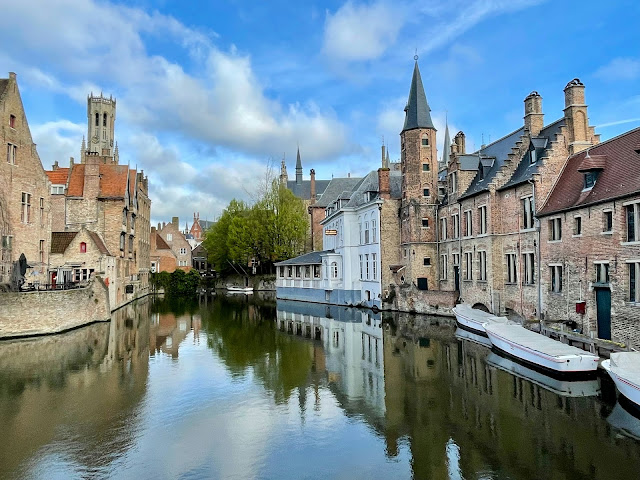Discovering Cuenca, Spain: A Journey Through Its Rich History and Natural Beauty
Cuenca is a charming and historic city located in the Castile-La Mancha region of Spain. With its picturesque medieval architecture, stunning natural surroundings, and rich cultural heritage, it has become an increasingly popular destination for travelers from around the world.
To help visitors make the most of their time in Cuenca, there are several travel guides available to guide them through the city's many attractions and experiences. In this blog post, we'll explore some of the highlights of Cuenca and what you can expect to find in a typical Cuenca travel guide.
Top Attractions
Cuenca is home to many incredible sights and landmarks that showcase its unique blend of history, art, and culture. Some of the most popular attractions to visit include the Cathedral of Our Lady of Grace, which dates back to the 12th century and is renowned for its Gothic architecture, and the Casas Colgadas (Hanging Houses), which are perched precariously on the edge of a gorge and provide breathtaking views of the surrounding landscape.
Other must-see landmarks in Cuenca include the Convento de las Carmelitas Descalzas, which features stunning frescoes and artwork, and the Museum of Spanish Abstract Art, which showcases works from both established and emerging artists.
Cultural Experiences
In addition to its impressive architectural and artistic heritage, Cuenca is also known for its lively festivals and events. Throughout the year, the city plays host to a range of celebrations that offer visitors a glimpse into the area's unique traditions and customs.
Some of the most popular festivals in Cuenca include Semana Santa (Holy Week), when the city comes alive with processions and pageantry, and the Fiestas de San Mateo, which celebrate the city's patron saint. Visitors can also experience traditional music and dance performances throughout the year and sample local cuisine at food fairs and markets.
Cuisine
Cuenca is famous for its delicious culinary offerings, which draw inspiration from both traditional Castilian cuisine and more modern fusion dishes. Some of the standout local specialties include cordero al horno (roast lamb), morteruelo (a hearty meat stew), and zarajos (grilled lamb intestines).
Visitors can also sample a range of local wines and spirits, including the famous Manchego cheese.
Travel Guides
To make the most of your visit to Cuenca, it's recommended to pick up a travel guide that can help you navigate the city's many attractions and experiences. These guides typically include comprehensive information on top sights and landmarks, as well as practical tips on transportation, safety, and language.
One of the most popular Cuenca travel guides is the "Travel Guide to Cuenca," which provides detailed information on the city's cultural offerings, culinary scene, and historic sites. It also includes a map of the city, recommendations for restaurants and bars, and advice on getting around using public transportation or taxis.
Overall, Cuenca is a beautiful and unique destination that offers something for everyone. Whether you're interested in exploring the city's rich history and art, sampling its delicious cuisine, or experiencing its lively festivals and events, a travel guide can help ensure that your trip is both enjoyable and memorable.
Things To do
There is no shortage of things to do in Cuenca, Spain. Here are some of the top activities and experiences that visitors can enjoy:
- Explore the Casas Colgadas (Hanging Houses): These iconic buildings are one of the most famous landmarks in Cuenca. They are built right on the edge of a cliff and provide breathtaking views of the surrounding landscape.
Visit the Cathedral of Our Lady of Grace: This stunning Gothic cathedral dates back to the 12th century and features intricate architectural details and beautiful stained glass windows.
Discover the Museum of Spanish Abstract Art: This museum showcases works by some of Spain's most prominent abstract artists, including Antoni Tàpies and Eduardo Chillida.
Attend a festival or event: Cuenca hosts several festivals throughout the year, including Semana Santa (Holy Week) and the Fiestas de San Mateo, which celebrate the city's patron saint.
Hike through the Serranía de Cuenca Natural Park: This beautiful nature reserve is located just outside the city and offers stunning hiking trails and wildlife spotting opportunities.
Sample local cuisine: Cuenca is known for its delicious culinary offerings, which draw inspiration from traditional Castilian cuisine as well as modern fusion dishes. Be sure to sample local specialties like cordero al horno (roast lamb) and manchego cheese.
Take a stroll through the historic center: Cuenca's medieval streets are full of charming narrow alleys, hidden courtyards, and quaint squares. A leisurely walk through the historic center is a great way to soak up the city's unique atmosphere.
Visit the Convento de las Carmelitas Descalzas: This former convent is now a museum that features stunning frescoes and artwork, as well as exhibits on the daily lives of the nuns who once lived there.
Check out the Paleontological Museum: This museum provides insight into the region's fascinating human occupation, with exhibits on prehistoric life, evolution, and paleontology.
Enjoy a night out on the town: Cuenca has a lively nightlife scene, with plenty of bars, clubs, and live music venues to choose from. Be sure to sample some of the local wines and spirits while you're out and about.
What is Cuenca Spain known for?
Cuenca, Spain is known for its stunning medieval architecture, breathtaking natural landscapes, and rich cultural heritage. It has been named a UNESCO World Heritage Site and is one of the most popular destinations in the Castile-La Mancha region of Spain.
One of the most iconic landmarks in Cuenca is the Casas Colgadas (Hanging Houses), which are perched precariously on the edge of a gorge and provide breathtaking views of the surrounding landscape. The city is also home to the Cathedral of Our Lady of Grace, a stunning Gothic cathedral that dates back to the 12th century.
Cuenca is also famous for its artistic heritage. The Museum of Spanish Abstract Art showcases works by some of Spain's most prominent abstract artists, and the city hosts several festivals throughout the year, including Semana Santa (Holy Week) and the Fiestas de San Mateo.
To its cultural offerings, Cuenca is also known for its delicious culinary specialties, which draw inspiration from traditional Castilian cuisine as well as modern fusion dishes. Some of the standout local dishes include cordero al horno (roast lamb) and manchego cheese.
Cuenca is surrounded by beautiful natural landscapes, including the Serranía de Cuenca Natural Park, which offers stunning hiking trails and wildlife spotting opportunities. Overall, Cuenca is a unique and captivating destination that has something to offer for everyone.
What are the best outdoor activities to do in Cuenca, Spain?
Cuenca, Spain is known for its stunning natural beauty and rich history. There are many outdoor activities that you can enjoy in this region, some of the best ones include:
- Hiking: Cuenca has many hiking trails that will take you through beautiful landscapes and offer stunning views of the surrounding mountains.
Cycling: The rolling hills and country roads around Cuenca make it a great place to explore by bike.
Rock Climbing: The rocky cliffs of Cuenca are popular with rock climbers from all over the world.
Kayaking: The Jucar River, which runs through Cuenca, offers a great opportunity to go kayaking and enjoy the stunning scenery.
Paragliding: For those looking for an adrenaline rush, paragliding is a popular activity in Cuenca, with plenty of opportunities to soar over the mountains.
Horseback riding: Exploring the countryside on horseback is another great way to take in the natural beauty of Cuenca.
Birdwatching: Cuenca's varied landscapes and ecosystems make it a great place to spot a wide variety of bird species.
Why is Cuenca an important city in Spain?
Cuenca is an important city in Spain due to its rich history, cultural heritage, and stunning natural beauty. Here are some key reasons why Cuenca is considered an important city in Spain:
Historical significance: Cuenca is a UNESCO World Heritage Site and is home to many well-preserved medieval buildings and structures such as the famous "hanging houses" (Casas Colgadas), which date back to the 14th century.
Cultural heritage: Cuenca has been inhabited for thousands of years and has a mix of influences from various cultures, including the Celts, Romans, and Moors. This has resulted in a unique blend of architecture, art, music, and cuisine.
Natural beauty: Cuenca is situated in a mountainous area and boasts stunning views of the surrounding countryside, including limestone cliffs, gorges, and the Júcar River.
Economic importance: Cuenca is an important center for agriculture, tourism and industry, particularly in the fields of construction materials and textiles.
Cuenca's combination of historical significance, cultural heritage, natural beauty, and economic importance make it an important city in Spain.
FAQs:
Where is Cuenca located? Cuenca is located in the central part of Spain, in the Castilla-La Mancha region.
What is the population of Cuenca? Cuenca has a population of around 55,000 people.
What is the history of Cuenca? Cuenca has a rich history that dates back thousands of years, with influences from various cultures, including the Celts, Romans, and Moors. The city is known for its well-preserved medieval buildings and structures such as the famous "hanging houses" (Casas Colgadas), which date back to the 14th century.
What is the natural beauty of Cuenca? Cuenca is situated in a mountainous area and boasts stunning views of the surrounding countryside, including limestone cliffs, gorges, and the Júcar River.
What are the main attractions in Cuenca? Some of the main attractions in Cuenca include the Casas Colgadas, the Cathedral of Our Lady of Grace, the Museum of Spanish Abstract Art, and the Serranía de Cuenca Natural Park.
What activities can you do in Cuenca? There are many outdoor activities that you can enjoy in Cuenca, including hiking, cycling, rock climbing, kayaking, paragliding, horseback riding, and birdwatching.
What is the cuisine like in Cuenca? Cuenca's cuisine is characterized by its use of local ingredients, such as game meat, trout, and mushrooms. Some popular dishes include morteruelo (a type of pâté), zarajos (grilled lamb intestines), and ajoarriero (a type of cod stew).




Comments
Post a Comment
It's easy to leave a comment on our blog – anyone with a Google account can do it. We invite you to share your experiences by leaving a comment as well.